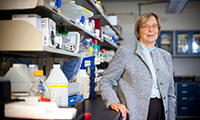Each year OTT helps launch a number of startup companies based around discoveries made by Emory faculty or staff. In most of those cases the faculty member remains at the university as a researcher or clinician while he or she simultaneously serves in some type of advisory role for the company. In some instances however faculty leave the university environment to strike out into the exciting world of startups. In this piece we talk to former Emory professor Harriet Robinson, PhD, who is now the Chief Science Officer at GeoVax, an Emory startup developing HIV vaccines based on previous work from her lab.
Before you created the HIV vaccine technology, had you ever given much thought to the commercialization of university discoveries?
Yes, I had previously wanted to commercialize a different vaccine technology that I discovered while at another university. At that time it was not possible due to state restrictions that limited the ability of faculty to license their own findings from the university. Those limitations stemmed from legislation created to curb legislators from awarding contracts to themselves or relatives.
What made you decide to follow the technology to a startup company rather than stay in academic research at Emory?

At a certain point, the vaccine technology needed expertise that was not present at Emory, for example, manufacturing, formulation, and regulatory expertise. It also needed full-time effort which was not compatible with being a full-time professor.
What has been the biggest challenge in moving out of the academic lab and into industry?
Maintaining funding focused on the commercial development of a product. For HIV vaccines in the developed world, funding is primarily from the NIH. This means that one has to steer a course that meets study section approvals as well as company objectives.
What is the biggest difference (or multiple differences) between an academic lab and an industry lab setting?
The biggest difference is that in industry, one is part of a team that has set out to achieve a goal. If something doesn’t work, the team figures out how to make it work rather than just going on to some other project that is interesting at the moment.
What advice would you give younger faculty interested in technology commercialization?
The small biotech world is very different from the university. Make sure you are really interested in working towards specific products and willing to give up the freedom (and resources) one has in the university to explore multiple different areas of research.
Many Thanks to Dr. Robinson for agreeing to participate! For more information on OTT’s efforts to support faculty entrepreneurship & startups check out our website: http://ott.emory.edu/startups/formation/index.html and http://ott.emory.edu/inventors/education.html. For additional information about GeoVax and their clinical stage HIV vaccine please see their website www.geovax.com.